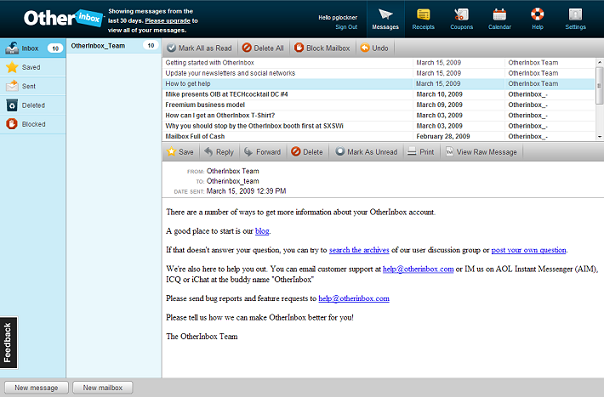A couple of years ago, the new launch from Webwalks, a universal inbox, news aggregator, password manager and kitchen sink-type application would have caught my eye. I’d rush out to try it, merging my multiple accounts under its one roof then wait to see how well my life improved, how much time I saved. But today, I’m more ambivalent about these sorts of applications. The concept of a universal inbox for tracking everything under the sun now leaves me cold.

That’s not to say that merging of social networks with the inbox in and of itself is a bad idea – Google Buzz, Xobni, and Outlook’s new social connector all offer innovative ways to augment the inbox experience. But there’s a key difference between these apps and those promising a “universal inbox” – they come to you, in the inbox you already know and love.
The Sad State of the Universal Inbox
The idea of a universal inbox is smart. On paper, that is. In our “information overloaded” modern age, messages come at us left and right from multiple email accounts, instant messaging programs, SMS on our mobile phones and from social networking sites like Facebook, Twitter and LinkedIn. And yet, none of the “universal inbox” applications have ever really taken off.
We’ve seen some worthy contenders though. Fuser, NutshellMail and Inbox2, for example, all merge messages from multiple platforms into one unified service. The more clever of these programs provide a way to make Facebook the interface you use to check your mail instead of forcing you into some new web service. However, even that option hasn’t attracted a large following.
Inbox2’s Facebook app “emailstream” only has 245 active users. NutshellMail’s does a little better with just over 5400 users. But when you think of the hundreds of millions of registered users on Facebook (400 million at the last count), these numbers aren’t even a drop in a bucket – they’re more like a grain of sand on a long stretch of beach.

The sites’ web destinations do a little better, but only a service called OtherInbox is doing well, with 67,000+ visitors last month. NutshellMail seems to be hanging in there, too – even growing its traffic a bit lately – and yet it attracted just under 24,000 uniques last month (according to Compete – not always the best source of statistics but good enough for this quick glance). An article on Digg’s homepage often get more hits than that! And it’s an understatement to say these numbers fall short of the millions who routinely log into online email accounts from Gmail, Hotmail and the like.
So what’s wrong? Why aren’t these services more popular?
People Want to Use Their Own Inbox, Not Some 3rd-Party Service
The answer to that question has its roots in what people expect from an email application. Email services from Yahoo, Microsoft, Google and yes, even AOL, among others are designed from the ground-up to provide that company’s vision of the best messaging experience. The applications are feature-rich with advanced options like POP3 and IMAP support, forwarding, filters, labels, auto-replies, vacation responders, spam filters and more.
Third-party aggregation-type applications don’t always have the same feature set. Plus, they typically have their own very un-email like interface – the applications tend to treat your email like activity streams on a social network, not critical messages that need to be filed, forwarded, replied to, or turned into tasks and calendar appointments. The exception here seems to be OtherInbox – they offer a real inbox complete with calendar tie-ins, stars for saving messages, spam filters and other typical email features. Not surprisingly, they’re the one doing the best out of all the other inbox applications listed here. However, they’re not actually a “universal” inbox. They don’t claim to merge all your messaging services into one – they simply help you better sort and organize your mail. So, really, they don’t count.

Socializing as an Inbox Layer
A better solution to the merging of messaging and social is, interestingly enough, exactly what Google has just launched with Buzz. Sure, that service has gotten off to a rough start with bugs, missing features and of course, the privacy issues, but the concept is solid. In Buzz, social networking becomes an additional layer to your inbox – one click and the display changes to a stream of social activity; click again and you’re back to your email. Important “social” messages (those you created, commented on or liked in Buzz) grab your attention by re-appearing in your inbox proper.

Other companies have similar ideas about socializing email. Xobni, for example, offers a plugin for Outlook that extracts social information about your contacts (among many other things). Microsoft, too, is just now launching its social layer for Outlook – the Social Connector which optionally lets you integrate LinkedIn and soon Facebook and MySpace into your inbox.

These programs all have a better shot at unifying the inbox to create a truly universal email application. They provide you with your “real” inbox and all its features while layering it with a social element. You don’t have to migrate to a new service entirely. Meanwhile the standalone universal inbox applications available today probably won’t last. They would be better off developing their service into a plugin or add-on for the webmail and desktop programs that people use now instead of trying to convince people to start checking their email elsewhere.

















